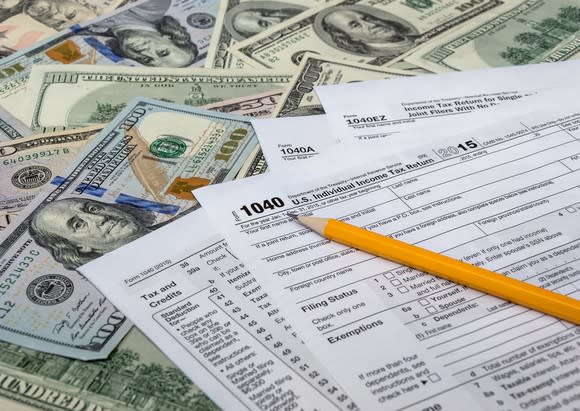Long-Term Capital Gains Tax Rates in 2018
If you sell an investment or other asset at a profit, the sale results in a capital gain. Long-term capital gains are taxed more favorably than short-term gains, and because the tax brackets have changed slightly for 2018, the long-term capital gains tax structure has changed slightly as well.
Here's a rundown of what qualifies as a long-term capital gain, the long-term capital gains tax rates, and a guide to the taxable income ranges these rates apply to in 2018.

Image Source: Getty Images.
What is a long-term capital gain?
A capital gain occurs when you sell property, such as a stock, at a price that's greater than what you paid for it. For example, if you bought a stock for $40 per share and sold for $50, you'd have a $10 capital gain for each share you sell.
The IRS sorts capital gains into two categories: long-term and short-term. A short-term capital gain is defined as a gain made on assets that you owned for one year or less. A long-term capital gain is made on an asset you owned for at least 366 consecutive days.
How are long-term capital gains taxed?
The reason for the distinction is that long-term capital gains are taxed at more favorable rates than short-term gains. Short-term capital gains are taxed as ordinary income, which means your marginal tax rate will apply to your short-term gains as well.
Meanwhile, long-term capital gains are taxed at one of three potential rates -- and all are much lower than the corresponding marginal tax rates. A 0% long-term capital gains tax rate applies to individuals in the two lowest (10% and 15%) marginal tax brackets. A 15% long-term capital gains tax rate applies to the next four brackets -- 25%, 28%, 33%, and 35%. Finally, a 20% long-term capital gains tax rate applies to taxpayers in the highest (39.6%) tax bracket.
It's also important to remember that certain high-income taxpayers pay an additional 3.8% net investment income tax, which kicks in above certain income thresholds.
The 2018 long-term capital gains "tax brackets"
Based on the 2018 IRS tax brackets, here's a breakdown of which taxable income ranges correspond to each long-term capital gains tax rate:
Long-Term Capital Gains Tax Rate | Single | Married Filing Jointly | Head of Household | Married Filing Separately |
|---|---|---|---|---|
0% | $0-$38,700 | $0-$77,400 | $0-$51,850 | $0-$38,700 |
15% | $38,700-$426,700 | $77,400-$480,050 | $51,850-$453,350 | $38,700-$240,025 |
20% | $426,700 or more | $480,050 or more | $453,350 or more | $240,025 or more |
Data Source: IRS.
These income brackets could change
The 2018 long-term capital gains tax structure could change significantly if the GOP passes a tax reform bill. While neither bill that has been revealed thus far changes the capital gains tax rates, both would change the income ranges to which each rate would apply.
To be clear, we don't have a single tax reform plan yet, and the eventual changes will likely be a compromise between the House and Senate versions of the Tax Cuts and Jobs Act, which are quite different at this point, so there's no way to know what kind of changes could be in store. The point is that the long-term capital gains tax rates discussed here reflect the current tax law, and there's a possibility that this information could change.
More From The Motley Fool
6 Years Later, 6 Charts That Show How Far Apple, Inc. Has Come Since Steve Jobs' Passing
Why You're Smart to Buy Shopify Inc. (US) -- Despite Citron's Report
The Motley Fool has a disclosure policy.

 Yahoo Finance
Yahoo Finance 